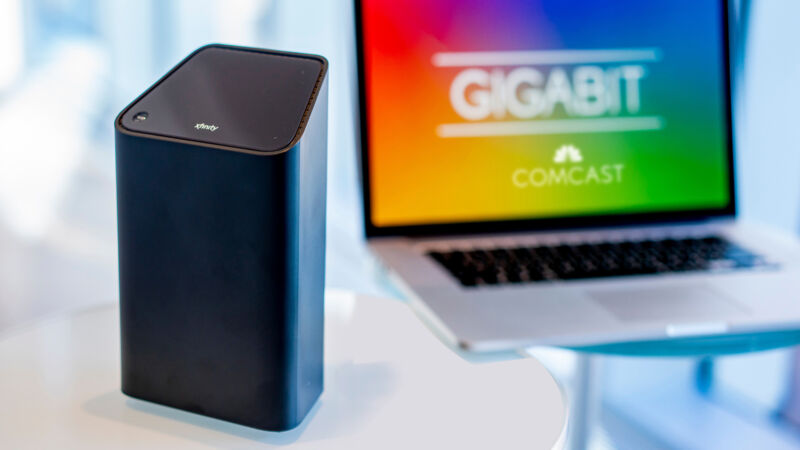
reader comments
35 with 32 posters participating
Comcast today offered the latest hint of a future in which its cable customers won’t be limited to 35Mbps upload speeds. Announcing a recent lab test, Comcast said its research team “deliver[ed] upstream and downstream throughputs of greater than 4Gbps” and that “future optimization” will allow “even greater capacity.”
This was “the first-ever live lab test” of a Broadcom “system-on-chip (SOC) device that will pave the way for Comcast to deliver multigigabit upload and download speeds over its hybrid-fiber coaxial (HFC) network,” Comcast said. It won’t require installation of more cables because the “technology works using the same types of connections already installed in hundreds of millions of homes worldwide,” Comcast said.
Cable customers have been waiting a long time for upload speeds that aren’t a tiny fraction of download speeds. Comcast’s cable uploads, ranging from 3Mbps to 35Mbps, are so low that Comcast hides them deep within its online ordering system. While cable download speeds of up to 1.2Gbps are prominently displayed, Comcast doesn’t tell customers what upload speeds they’ll get until they enter a valid credit card number.
Comcast justified its tactic of hiding upload speeds by saying that its “website reflects the way customers use the Internet, with downstream overwhelmingly dominating usage.” But occasionally, such as in today’s announcement, Comcast acknowledges that customers want higher upload speeds.
“This milestone is particularly exciting because this technology is an important step forward toward unlocking multigigabit upload and download speeds for hundreds of millions of people worldwide, not just a select few,” Comcast executive Charlie Herrin said in the announcement.
“Full duplex” DOCSIS
Comcast does offer a residential fiber service with upload and download speeds of 2Gbps, but availability is limited and the service costs $300 a month, plus installation and activation charges of up to $1,000 combined. The fiber service requires the installation of new wires into each home, but the newly announced lab test delivered multi-gigabit upload and download speeds over the standard cable wires that Comcast has installed throughout its 39-state territory.
The test used a Broadcom SOC powered by the latest version of DOCSIS, the Data Over Cable Service Interface Specification. The Broadcom “device is expected to become the world’s first production silicon to be developed using the DOCSIS 4.0 Full Duplex standard, which represents an evolutionary leap forward in the ability to deliver ultra-fast speeds over HFC [hybrid fiber-coaxial] networks,” Comcast said. “One of the most important breakthroughs in the DOCSIS 4.0 standard is the ability to use network spectrum more efficiently, allowing operators to dramatically increase upstream speeds without sacrificing downstream spectrum to do so.”
DOCSIS 3.1 specification released in 2013 theoretically allowed 10Gbps downloads and 1Gbps upload speeds, but actual implementations never came close to those numbers. An update to DOCSIS 3.1 finalized late in 2017 was supposed to bring download and upload speeds of 10Gbps, and the cable industry unveiled a “10G” marketing campaign in January 2019 to boast of those symmetrical 10Gbps speeds. Comcast today called its newest test “an important step forward on the path to 10G.”
The full-duplex version of DOCSIS 3.1 was updated and renamed “DOCSIS 4.0.” Despite the “full duplex” name, the cable industry has lowered the estimated upstream speeds from 10Gbps to 6Gbps.
“Current DOCSIS 3.1 cable modems support capacities up to 5Gbps downstream and 1.5Gbps upstream,” the cable-industry group CableLabs says. “DOCSIS 4.0 cable modems will support capacities up to 10Gbps downstream and 6Gbps upstream.”
Comcast said that a “key advantage of DOCSIS 4.0 Full Duplex is that it establishes a foundation for operators to deliver multigigabit speeds over their existing networks to the connections already in hundreds of millions of homes around the world, without the need for massive digging and construction projects.” Comcast called it “a powerful new tool to support our mission of delivering the best possible connected experiences to our customers,” but it didn’t say when those customers will be able to buy a future “full duplex” service.
Smaller upload increase possibly on tap
Comcast in October 2020 said it achieved a “technical milestone” that delivered 1.25Gbps download and upload speeds over existing cable wires during testing at a home in Jacksonville, Florida. While gigabit upload speeds over cable would be a massive improvement, it likely isn’t anywhere close to being implemented. It’s also not clear when Comcast will raise cable upload speeds to anything higher than 35Mbps—Comcast hasn’t even confirmed an increase to 50Mbps uploads, which is already offered by WOW on that company’s gigabit-download plan.
Currently, Comcast’s 25Mbps download plan comes with 3Mbps uploads; the 100Mbps and 200Mbps download plans both have 5Mbps uploads; the 400Mbps download plan has 10Mbps uploads; the 800Mbps plan has 15Mbps uploads; and the 1Gbps download plan (1.2Gbps in some areas) comes with 35Mbps uploads. By contrast, fiber-to-the-home providers generally provide symmetrical upload and download speeds of up to 1Gbps.
Comcast did hint at higher upload speeds “in the near term” using DOCSIS 3.1, but it didn’t specify what those speeds will be or say when they will be available:
Even as Comcast works to test and deploy Full Duplex DOCSIS to enable multigigabit upload and download speeds in the future, the company is leveraging the technologies from the October trial, along with DOCSIS 3.1 in the upstream, to increase speed and capacity in the near term.
The October 2020 test “deliver[ed] 1.25 Gig symmetrical speeds over a live, all-digital network by leveraging advances in Distributed Access Architecture, Remote PHY digital nodes, and a cloud-based virtualized cable modem termination system platform,” Comcast said. In the more recent test announced today, the demonstration occurred in a “simulated” environment instead of a home.
“Comcast technologists in Philadelphia and Denver conducted the test by installing the Broadcom SOC in a simulated network environment to track the performance of its Full Duplex DOCSIS features—including echo cancellation and overlapping spectrum—which combine to support substantial improvements in network throughput,” Comcast said.






